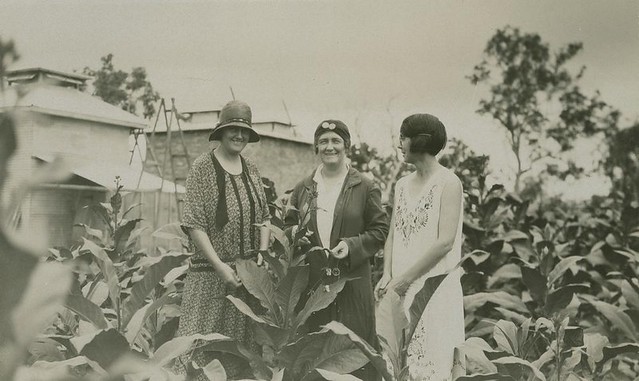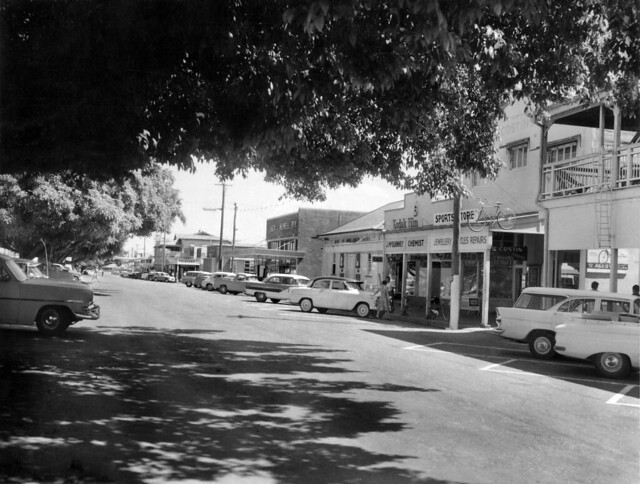The town of Mareeba is one hour drive west of Cairns, in Far North Queensland, Australia.
Mareeba has a cosmopolitan feel, abundant wildlife and diverse history and sites, to explore.
The Muluridji People
Before European settlement, the Mareeba area was inhabited by the Muluridji people, who lived a hunter/gatherer lifestyle.
The name Mareeba is derived from the local Aboriginal language. The word meaning, "meeting of the waters",
refering to the point at which the Barron River is joined by Granite Creek.
At Bare hill, on the borders of the rainforest near Mareeba, a granite rock shelter was found which contained rock paintings and stone implements
belonging to the original Aboriginal people. Mareeba today, still has a large indigenous population.
Most Aboriginal groups had many taboos. One common example was the taboo of saying the name of a deceased person and one`s own name. The main reason was the fear of the name being used by sorcerers. Other taboos relate to blood, hair, places where death has occurred, and certain types of food.
Certain people were also taboo, such as women during menstruation and childbirth. Mother-in-law avoidance was also common.
Important aspects of Aboriginal
cultures involved travelling to sacred places, performing ceremonies, passing on knowledge and stories and taking care of the country. The relationship to the land has both obligations and rights.
Before European settlement, there were about 600 and 700 dialects of 200 to 250 languages spoken by the Aboriginal people of Australia. However, Aboriginal languages were spoken and not written down until Europeans arrived.
 |
| North Queensland Aboriginal person, early 1900s, Kaye |
 |
| Aboriginal culture display at the Mareeba Heritage Museum Merryjack |
An Expedition
Officially,
James Venture Mulligan was the first European to sight Mareeba, when in April 1875, he was sponsored by the Queensland Government to lead an expedition.
The expedition, which included an Aboriginal man named "Charley", passed through the area which would later become Mareeba, Atherton, and
the Herberton Range. Tin was also found
during this expedition, in the Wild River, but little gold.
 |
| James Venture Mulligan (1837 - 1907) was an Ireland-born Australian prospector and explorer |
The Settlers Arrive
In 1877, John Atherton was the first European settler of Mareeba, bringing cattle and making his home at Emerald End, which is just north
of the town today. In the beginning, Mareeba was known as Granite Creek.
Atherton, a prospector and explorer, also had the tableland area between the Palmer River and the headwaters of the Burdekin named after him. By the 1890s, the Jackson, Marnane, Masterson and Ord
families had moved into Mareeba to establish cattle stations. Sergeant Orr became Mareeba's first police officer.
 |
| John Atherton (1837 – 1913) was an explorer of the Far North Queensland |
The Bump The Bump Track, a supply route which began in Port Douglas and went through steep
rainforest terrain, continuing north-west of Mareeba, and eventually arrived at the Hodgkinson goldfield towns of Thornborough and Kingsborough, was used by travellers and to haul goods, until the opening of the first section of the Cairns to Kuranda Railway in 1891. One section of this track is very steep and is popular with bike riders.
Cobb & Co.
When a road was built in 1880 from Port Douglas to the goldfields at Herberton, Mareeba became a busy coach stop for Cobb & Co.
With the coming of the railway in 1893, the Cobb and Co. coach, once
driven by Jack Warper, on the Mareeba-Herberton run, was left to crumble to dust in a backyard at the rear of Mrs Strattman's Railway Hotel.
 |
The Roaring Days of Cobb and Co—A picture of one of the old-time coaches in use on the North-
Western lines. Sunday Mail (Brisbane, Qld. : 1926 - 1954), Sunday 30 June 1929 |
The Rail Arrives
The Cairns-Kuranda railway line was extended to Granite Creek in 1893 and the town became known as Mareeba rather than Granite Creek. Although many still referred to Mareeba as the “The Granite Creek Stopover”.
 |
| Cairns to Mareeba, no. 15 tunnel, QLD, Australasian (Melbourne, Vic. : 1864 - 1946), Saturday 2 December 1899 |
 |
| Queensland Country Life (Qld. : 1900 - 1954), Sunday 1 December 1901 |
With European settlement, hunting, foraging and fishing became increasingly difficult for Aboriginal people. Land loss, exposure to diseases to which Aboriginal people had no immunity, and violent conflicts had devastating effects.
 |
| Muluridji camp at the Northern end of Walsh Street, Mareeba, QLD, c 1895 |
Businesses Develop
In the 1890s, a town survey was completed by Edward Rankin. One of Mareeba's roads is named after him. Other roads, such as Atherton, Eccles, Hort, Lloyd, Middlemiss and Walsh Streets, were named after other prominent pioneers.
Many businesses opened in Mareeba as it became more prosperous.
Jack and Newell’s was one of the first.
Other businesses include, Peter Berglund’s shoe shop, Dickson’s bakery, Danks’ pharmacy and Smith’s drapery. Industries included Bechtel’s soap factory, Couper’s iron and brass foundry, Rudolph Hampe’s cordial factory, Tom Mann’s brickworks, Pearce’s maize-crushing mill and the nearby, Biboohra meatworks.
Read More.
 |
| Jack and Newell general store, built around 1893, Mareeba QLD |
Mr Cummings was a Mareeba saddler at one time
and Mr Burrows had a shop and residence on the Byrnes-Rankin street comer, which was later used as Mareeba's original courthouse.
William Dickson had a bakery at the corner of Byrnes and Lloyd street. Jack Fenwick was a blacksmith and wheel-wright, while Bob Male was one of the early carriers. Middlemiss Street, Mareeba, is named after the butcher, William Middlemiss.
George Rice had a shop at the northern end of Byrnes street, and Thomas William Sullivan operated the Royal Hotel at the southern part of Bynes street. This hotel was later taken over by Jim Brown's folk and dismantled. It became part of the present Royal Hotel.
The first Mareeba Hospital
was established in 1894. However, it is not surprising, considering the importance of the mail coach to the town's development, that the first building in Mareeba was a
hotel called the Royal Mail, which was owned by a family in Atherton and run by Eccles and Lloyd. The hotel, which was located on the south bank of Granite Creek, no longer exists.
 |
| Mareeba Hospital, QLD, North Queensland Register (Townsville, Qld. : 1892 - 1905), Monday 29 May 1905 |
Mining attracted many settlers and hopeful diggers to the Mareeba area. Wolfram and molybdenite were mined mainly at Wolfram Camp, Mount Carbine, Mount Perseverance and Bamford. Mareeba became an important service centre.
The Developing Town |
| Queensland National Bank branch at Mareeba, Queensland. The bank was established in Mareeba on 10 December 1906. State Library of Queensland |
 |
| The Queensland National Bank building at Mareeba, built by Marcus and Frances Brims. State Library of Queensland |
 |
| Some of the businesses include: Mareeba Auction Mart owned by F. Cruckshank; Carthew & Son, drapers and Ryan's Federal Hotel. n.d. State Library of Queensland |
Professional photographer: Harriett Pettifore Brims
Born in 1864 at Yandilla, Queensland, Harriett Pettifore Elliot married Donald Gray Brims, an engineer from Caithness in Scotland. In 1894, the Brims family was living at Ingham. In 1902, Harriet is listed in Pugh’s
Trade Directories as the owner of the "Britannia Studios", at Ingham.
In 1903, the family moved to Mareeba where Donald, Harriet's husband, started a joinery works, which is extended by two sons of Donald and Harriet. The company which is named "Brims Bros", builds the Queensland National Bank and the Anglican Church at Mareeba. Harriet also sets up her photography business in Mareeba, using dry-plate cameras manufactured by her husband.
Subjects of Harriet's
photography included her family and local Mareeba, Melanesian labourers who were transported to live and work in the northern canefields, to views of the Gairloch and Macknade sugar plantations, the copper smelters of Chillagoe and landmarks such as Wallaman Falls near Ingham.
 |
| Portrait of Harriett Brims in Mareeba, Queensland, circa 1890s. Harriett Brims was an early Queensland photographer. |
 |
| Men, possibly staff from D. G. Brims' joinery works, sitting atop a loaded horsedrawn wagon at Mareeba, early 1900s. State Library of Queensland |
 |
| Timber outside D. G. Brims & Sons' Sash & Door Factory at Mareeba, Queensland |
Early 1900s |
| View of St. George's Anglican Church at Mareeba, Queensland, 1905. Church at Mareeba built by Marcus and William Brims, ca. 1904 |
 |
| North Queensland Register (Townsville, Qld. : 1892 - 1905), Monday 29 May 1905 |
 |
| Town of Mareeba, QLD, as seen from the train, Week (Brisbane, Qld. : 1876 - 1934), Friday 7 February 1908 |
 |
| North Queensland Register (Townsville, Qld. : 1892 - 1905), Monday 29 May 1905 |
 |
| Main Street, Mareeba, QLD. Week (Brisbane, Qld. : 1876 - 1934), Friday 7 January 1910 |
 |
| Bush tent maker at Mareeba, Week (Brisbane, Qld. : 1876 - 1934), Friday 7 January 1910 |
 | | Dunlop's Hotel in Main Street, Mareeba, Qld, circa 1910 |
 |
| Post and Telegraph Office, Mareeba, QLD, Week (Brisbane, Qld. : 1876 - 1934), Friday 7 January 1910 |
 |
| Mareeba cricket team, QLD, Northern Herald (Cairns, Qld. : 1913 - 1939), Friday 18 December 1914 |
 |
| Masonic Lodge and English Church, Mareeba, QLD, Northern Herald (Cairns, Qld. : 1913 - 1939), Friday 19 March 1915 |
 |
| Australia Day Procession, Mareeba, QLD, Northern Herald (Cairns, Qld. : 1913 - 1939), Friday 13 October 1916 |
 |
| Pariotic procession at Mareeba, QLD, Northern Herald (Cairns, Qld. : 1913 - 1939), Friday 24 September 1915 |
 |
| Picnic scene at Mareeba with two automobiles, circa 1910-1920. State Library of Queensland |
 |
| Mareeba Convent and School in Constance Street, Mareeba, Queensland, n.d. Brims, Harriett Pettifore, 1864-1939 ; John Oxley Library, State Library of Queensland |
 |
| Mareeba Town Band, Queensland, n.d. State Library of Queensland |
 |
| Miners? packing up camp in the Mareeba District, QLD, 1910-1920 |
 |
| Byrne Street, Mareeba, QLD, circa 1914 |
 |
| Aboriginal and Islander football team, Mareeba, QLD, Week (Brisbane, Qld. : 1876 - 1934), Friday 8 May 1914 |
By 1916 the population of the Mareeba district was estimated to be over 1,200.
The Government Assay Office at Mareeba, for assaying, testing and hallmarking of precious metals, to protect consumers from buying fake items, was built in 1916. It is behind the Court House on the corner of Hort and Constance Streets.
 |
| The Government Assay Office at Mareeba, QLD, was built in 1916. Northern Herald (Cairns, Qld. : 1913 - 1939), Friday 1 September 1916 |
1920s |
| Bales of cotton ready for market, Mareeba, QLD, ca. 1920, SLQLD |
 |
| Bales of cotton from W. Smallwood, Mareeba, QLD, 1922. State Library of Queensland. |
 |
| Cairns Post (Qld. : 1909 - 1954), Wednesday 2 May 1923 |
 |
| Mareeba, QLD, 1924 |
 |
| Cairns Post (Qld. : 1909 - 1954), Saturday 29 May 1926 |
 |
| Visitors attending the opening motor cycling event at the Mareeba Speedway, 30 April 1927. State Library of Queensland |
Tobacco Plantations
A man named Burdett was growing tobacco in Mareeba in the 1890s. However, it wasn't until the 1920s that tobacco became the main agricultural crop for the Mareeba and Dimbulah region growing 60% of Australia's tobacco at one period.
In 1937 there were 320 British, 109 Italians and eight Albanian producers of tobacco registered under the Excise Act in the Mareeba district (
1). Later, many migrants from Italy, Yugoslavia and Germany settled in Mareeba, to work in the tobacco industry.
Felix and Gino Piagno left Bando, Northern Italy and arrived in North Queensland on the 15 February 1934. They began work at their father's tobacco farm, planting tobacco by hand; dry cropping and relying on the wet season rains. This was tobacco
farming before the damming of the Barron River and the creation of Lake Tinaroo in 1958. See
here
Today mangoes, avocados, lychees, longans, pineapples and coffee are grown around these areas, watered by the Tinaroo Dam.
 |
| Voice of the North (NSW : 1918 - 1933), Monday 12 December 1932 |
 |
| Businesses in Mareeba and the Royal Hotel on the right, Queensland, 1942, State Library of Queensland |
 |
Mareeba Picture Theatre, Queensland, 1942 Script under photograph reads: "Only theatre in town''.
|
Construction of Mareeba airfield began in May 1942.
In November 1942, after Japan entered World War II, the Commander-in-Chief of the Australian Military Forces, Lieutenant-General Thomas Blamey, ordered a survey of the Atherton Tableland, with the idea of developing a centre for rehabilitation and
training for volunteer army troops of the Second Australian Imperial Force, who had returned from the Middle East.
 |
| American soldier in slit trench, Mareeba, Queensland US Army 2nd Station Hospital in Mareeba, circa 1942 |
From 1942 to 1945, up to 10,000 Australian and U.S. service personnel used Mareeba Airfield as a staging post for battles in New Guinea and the Pacific.
Another connection to the war period is a stone fireplace and chimney, which now forms part of Mareeba Scout Hall. This building is said to have been part of a log cabin hut belonging to the quarters of
the commanding officer of the First Australian Army, Major-General Murray, during WWII.
In 1943 the Assay Office became the district headquarters for the Australian Women's Army.
Mareeba railway station during the war period was the main depot, in the region, for materials needed in the construction of roads, army camps, warehouses, hospitals and other defence facilities.
3,579 U.S. troops and many Australian troops came to the area.
 |
| MAREEBA, QLD. 1943-07-27. TROOPS OF THE 2ND AUSTRALIAN CORPS SPECIAL SALVAGE UNIT, AT WORK ON A FLYING FORTRESS AIRCRAFT. AWM |
 |
| MAREEBA, QLD. 1944-10-02. TROOPS OF THE 1ST PARACHUTE BATTALION, MARCHING WITH PRECISION AT THE CONCLUSION OF A BATTALION PARADE HELD AT THE AIRSTRIP. AWM |
 |
| MAREEBA, QLD. 1944-05-17. MEMBERS OF THE AUSTRALIAN WOMEN'S ARMY SERVICE, ON POSTING TO HEADQUARTERS, FIRST AUSTRALIAN ARMY, ARRIVING AT THE RAILWAY STATION IN THE TABLELANDS AREA. IDENTIFIED PERSONNEL ARE, LEFT TO RIGHT:- QF141190 SERGEANT E.J.S. WAGLAND (1); QF141198 LANCE CORPORAL P.A. GREEN (2); QF141876 CORPORAL E.G. LOUTTIT (3); QF266918 DRIVER R. WHYE (4). AWM |
 |
| Sun (Sydney, NSW : 1910 - 1954), Sunday 27 August 1944 |
 |
| Postcard of Mareeba, QLD |
 |
| Mareeba, QLD, no date |
 |
| Some of the drovers who brought the Maytown mob down to Mareeba. Queensland Country Life (Qld. : 1900 - 1954), Thursday 4 August 1949 |
1950s
 |
| Mr Bruno Feretti alongside a crop of Virginia Gold Leaf, Mareeba, QLD, Townsville Daily Bulletin (Qld. : 1907 - 1954), Wednesday 6 January 1954 |
 |
Mr A. Dunlop opened Dunlop's Hotel, Mareeba in 1906. Mareeba, QLD
|
1960s
The Mareeba Drive-in opened in 1960 as the Rodeo Drive-in. It was closed in 1998 but later re-opened in 2002.
 |
| Byrnes St, Mareeba, QLD, c1960, Kaye |
1970s
 |
| Postcard Mareeba, QLD, 1970s, DW |
Around Mareeba |
Ruins of US Officers Fireplace, Mareeba, QLD
|
 |
| The old Civic Theatre building in Byrnes Street, Mareeba, QLD Stephen Coles |
 |
| The Ant Hill Hotel, Mareeba, QLD |
 |
| 123 Byrnes St, Mareeba, QLD. Known as Dunlops Hotel until 1996, then as the Highlander and now the Peninsula. |
.jpg) |
| The Government Assay Office, Mareeba, was built in 1916, QLD |
 |
| Heritage house, Mareeba, QLD |
 |
| Mareeba once famous for tobacco growing, QLD |
 |
| Old Mareeba Fire Station built about 1938, QLD |
_(2010).jpg) |
| Mareeba Shire hall, designed by Eddie Oribin and built from 1960 to 1961, QLD |
 |
| Obelisk with a digger statue on the top, Mareeba, QLD |
 |
| July 1st 1947 the the North Queensland Tobacco Growers' Co-operative Association was formed, having its headquarters at Byrnes Street, Mareeba, QLD |
 |
| At the Mareeba Heritage Museum, QLD |
 |
| St Thomas' School, Mareeba, QLD built circa 1931 |
 |
| Tank at the Beck Aviation Museum, Mareeba, QLD |
 |
| Queenslander-style house Walsh Street, Mareeba, QLD |
 |
| The Mareeba Mosque built in 1970, QLD |
Things To Do and Places To Go


























































.jpg)



_(2010).jpg)















